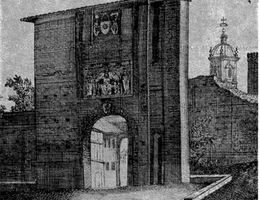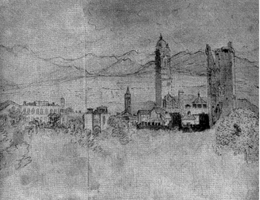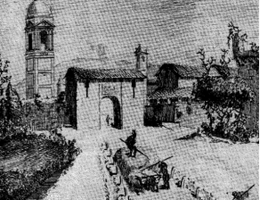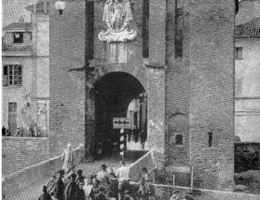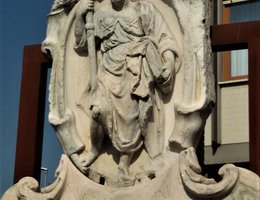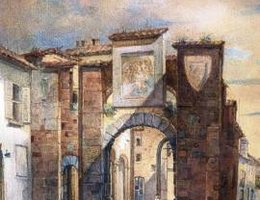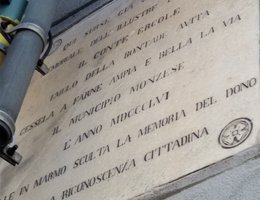di Gaia Busciglio
Le antiche porte di Monza risalgono alla prima metà del XIV secolo, periodo in cui fu costruito l’ex Castello Visconteo (sostituito oggi dall'edificio che ospita la “Rinascente”) e di conseguenza fu munito di un sistema di difese continuo, comprendente la cinta muraria e il fossato realizzato verso est, a partire dalla deviazione del Lambretto.
Nel XIV secolo vi furono delle lotte interne tra due grandi famiglie di Milano: i Torriani – guelfi - e i Visconti – ghibellini - . Monza appoggiò questi ultimi e nel 1312 decise di diventare ghibellina ma nel 1322 fu occupata e saccheggiata dai Torriani, che ne fecero la loro base contro i Visconti. Questi tuttavia nel 1324 riconquistarono la città e realizzarono opere di difesa del borgo, a protezione anche degli abitanti del circondario che all'occasione potevano rifugiarsi a Monza.
Nelle “Memorie storiche della città di Monza”, troviamo riferimento anche alle porte urbiche : “le otto porte erano : la porta Nuova ossia di Milano, la Carnaria, la Battifreda, quella di s. Biagio, di Carrobiolo, di Agrate, di Lecco e di Lodi.” (G. Marimonti, "Memorie storiche della città di Monza" 1841, p.142). Di queste otto porte, tre erano preesistenti le costruzioni difensive dei Visconti, cui poi ne furono aggiunte altre cinque : “Delle tre antiche la porta così detta Carnaria nel 956, probabilmente porta dei carri, era in vicinanza della porta Nuova, munita di torre, la quale dicesi dal popolo torre di Cesare, non si sa bene il perché; la porta Gradi o de’Gradi, che ai tempi di Bonicontro chiudeva con chiavi da uno de’littori del pubblico, e la porta Battifreda, così nominata negli statuti di Monza, che custodiva dai medesimi littori in tempo di notte. Queste porte, la più parte delle quali presero il nome dalle vicine chiese, dai luoghi principali a cui mettono, si ridussero alle quattro moderne, cioè alle porte Nuova, d’Agrate, Carrobiolo e di s. Bagio; la quale ultima fu detta pure nel 1441 porta de ulmo.” (G. Marimonti, "Memorie storiche della città di Monza" 1841, p.142).
Tuttavia in altre fonti si trova testimonianza di sette invece che di otto porte. Gia nel XVIII secolo, il canonico Campini ci riferisce che delle sette porte, che alla sera venivano chiuse, tre erano state murate, e rimanevano funzionanti porta Nuova (largo Mazzini) proprio sotto il castello, porta di san Biagio (inizio di via Prina), porta di Carrobiolo (incrocio di via Massimo d’Azeglio con via Frisi), porta de Gradi (tra via de Gradi e via Bergamo). Erano state dunque chiuse porta Carnaria (da Campini chiamata porta Regina o di Cesare), porta Lodi e porta di Lecco.
Il Frisi le descrive così: “Sono esse fabbricate a guisa di picciol forte, coi merli, saracinesche e ponti levatoi a foggia delle città murate, ed hanno il loro sobborgo, specificato col titolo delle porte medesime”.L’antica porta monzese era grossa e alta, merlata, a 2 portoni, uno verso l’interno l’altro verso l’esterno. Quella che dava verso l’interno aveva una piccola porticella di lato, detta "del soccorso", e il ponte levatoio che veniva calato di notte, l’altra aveva sfori o guide delle saracinesche che ricadevano sull’ampiezza dell’arco.
Porta Nuova, aperta verso Milano, è quella di cui si conservano più rappresentazioni. Tra le più significative: un disegno a penna di fine Settecento di un ignoto, che rappresenta Monza vista fuori da porta Nuova, considerato piú attendibile di un’incisione francese del 1780 che mostra largo Mazzini immersa in un’atmosfera agreste. Osservando l’incisione di porta del Castello Visconteo, del Frisi (1794) è invece ben visibile il grande arco della porta in cui si distinguono due rilievi in marmo, oggi conservati al Castello Sforzesco di Milano. Il primo proprio sopra l’arco, d'autore ignoto, rappresenta la Madonna col Bambino in grembo - con ai suoi lati sant’Ambrogio (a destra) e san Giovanni Battista (a sinistra)- nell’atto di proteggere i monzesi (a destra le donne e a sinistra gli uomini) sotto il suo mantello. Nell'altro rilievo, sotto la grondaia, si nota lo stemma del borgo (luna crescente) tra due stemmi degli antichi signori Visconti.
Porta Nuova, come dice il Marimonti, fu poi distrutta nel 1839, per allagare la strada militare.
Porta de Gradi sopravvisse più a lungo (circa 70 anni in più di porta Nuova) anche se al momento della sua demolizione era per gran parte ricostruita, come ci dice Campini e come si può vedere dalle immagini fotografiche di un esame archeologico, dove si nota chiaramente che i merli non erano quelli originali. Non sono stati ritrovati gli stemmi che ornavano la porta, ma è rimasta la targa del 1704 dedicata a San Giacomo, attualmente posta sul campanile della chiesa di San Giacomo in via Michelangelo Buonarroti. Porta De Gradi era situata proprio sul "Punt de la Mariota" (Ponte della Mariotta), che collega via Bergamo con via De Gradi: il nome di questo ponte ha origine dalla simpatica ortolana, Mariotta, che aveva la sua bancarella sotto l'arcata della porta.
Oggi accanto al ponte, tra via Bergamo e via Pesa de Lino è collocato il rilievo di San Giacomo che fino al 1908 serviva da ornamento per Porta de Gradi. Il Santo fu scelto perchè protettore dei cappellai, molto venerato a Monza, città storicamente famosa per i suoi cappellifici, e soprattutto in questa zona dove sorgevano numerose fabbriche sulle sponde del fiume.
L'ultima delle tre porte di cui si possano conoscere oggi le fattezze, grazie a un acquerello di Giosuè Bianchi, è porta San Biagio, chiamata anche "Porta de ulmo" probabilmente per un olmo che si trovava lì accanto in passato. È la tipica porta monzese fortificata con la particella del soccorso dove era alloggiata la stanga per il ponte levatoio. È poco visibile sopra l'arcata una raffigurazione della Sacra Famiglia. Oggi, all'incorcio tra via Manzoni e via Prina, l'antica presenza della porta è ricordata da una targa, poco visibile alle spalle del semaforo.
ENGLISH VERSION
Monza gates were built in the first half of the 14th century, the same period in which the Castello Visconteo—today replaced by the Rinascente—was constructed, surrounded by walls and defended on the east by the moat Lambretto. This fortified system was necessary because during the 14th century the Torriani, of the Guelph party, were at war with the Visconti, of the Ghibelline party. Monza supported the latter, and in 1312, decided to become a Ghibelline city. Later, in 1322, Monza was occupied and sacked by the Torriani, who used Monza as a base against the Visconti. In 1324, the Visconti reconquered the city and realized defensive work to protect the city and the neighbor communities who could find refuge in Monza. In the book "Memorie storiche della città di Monza" there are references to the city gates: “The eight gates were: Porta Nuova or di Milano, Porta Carnaria, Porta Battifreda, Porta San Biagio, Porta di Carrobiolo, Porta di Agrate and Porta di Lecco e di Lodi.” Of these eight gates, three were built before the Visconti’s defensive construction was made. Five gates were added later: “Of the three antique gates, the one that in 956 was called Carnaria, was nearby the Porta Nuova, which had a tower, and was called by the population the tower of Caesar, but it is not clear why. Porta Garibaldi or de’ Gradi at the time of Bonicontro was closed with the keys by one of the officials, and the Porta Battifreda, so called in the statutes of Monza. It was a shelter for the officials during the night. Great part of these gates took the name of the churches and principal places nearby. At some point their number was reduced to four, Porta Nuova, D’Agrate, Carrobiolo and Porta di S. Biagio. In 1441, the latter was called Porta De Ulmo.” In other written sources, however, there are lists of seven gates instead of eight.
In the 18th century, Campini wrote that three of the seven gates that were closed at night, were walled up. The remaining gates were Porta Nuova (largo Mazzini), Porta di San Biagio (at the beginning of via Prina), Porta di Carrobiolo (at the intersection between via Massimo d’Azeglio and via Frisi), Porta de Gradi (between via de Gradi and via Bergamo). The following gates were closed: Porta Carnaria, called Porta Regina or di Cesare by Campini, Porta Lodi and Porta di Lecco. At night, the gates were closed. This is an important element that help us understand the antique society of Monza. Frisi described the gates with these words: “They were made as small fortresses, with merlons, shutters, and drawbridges. Each neighborhood took the name of its gate.” The ancient gates in Monza were large and tall, crenellated, with two portals, one pointed towards the city and the other towards the external lands. On the side towards the city, the city gate had a small door on the side, called porta del soccorso and the drawbridge that was lowered at night. The external side of the gate had the shutter frames.
Porta Nuova, oriented towards Milan, is the one that most has been represented graphically. There are drawings dated to the 18th century that represent the gate with more or less accuracy. An accurate drawing of the bridge was made in the 18th century by an anonymous artist (fig. A). It represents Monza seen from Porta Nuova. A less accurate incision was made by a French incisor in 1780 (fig. B), showing Largo Mazzini with a bucolic landscape. The incision in Frisi book (1794) clearly shows the large arch of the gate and two marble reliefs, now preserved in the Castello Sforzesco in Milan. The first panel is above the arch. Made by an anonymous artist, it represents the Virgin with the Child on her lap, flanked by St. Ambrose on the right and St. John the Baptist on the left. The Virgin protects the people of Monza—the women to the right and the men to the left—by keeping them under her mantel. A high relief below the gutter, represents the stemma of the district, the crescent moon, between two stemma of the Visconti. Miramonti writes that Porta Nuova was destroyed in 1839 as to enlarge the military road.
Porta de Gradi will last 70 years longer than Porta Nuova. When the gate was demolished, it had been in great part reconstructed, as Campini reports. We can see the reconstructed parts in the photographs that show that the original battlements were replaced. No stemma has been found on this gate. Instead there is a panel representing St. James (1704) that is now displayed on the bell tower of the church of St. James in via Michelangelo Buonarroti. Did you know that Porta de Gradi was originally located on the Punt de la Mariota (the bridge of a woman called Mariota) that connects via Bergamo with via De Gradi? The bridge was named after the charming greengrocer Mariotta. She indeed had her stand under the arch of the gate. Today, the memory of Mariotta is kept in the sign of a café nearby. Next to the bridge, between via Bergamo and via Pesa de Lino we can see the relief of St. James that embellished Porta De Gradi until 1908. Why was St. James represented? Because St. James was the protector of the hatters and Monza was very devoted to this saint because the city was famous for its hat factories.
Porta San Biagio is the last of the three gates we can still see today in a watercolor by Giosuè Bianchi. The gate is also called Porta de Ulmo probably for an elm that was there at that time. It is the typical fortified Monza gate with the Porticella del Soccorso and the drawbridge. Above the arch there was a representation of the sacred family.
BIBLIOGRAFIA
